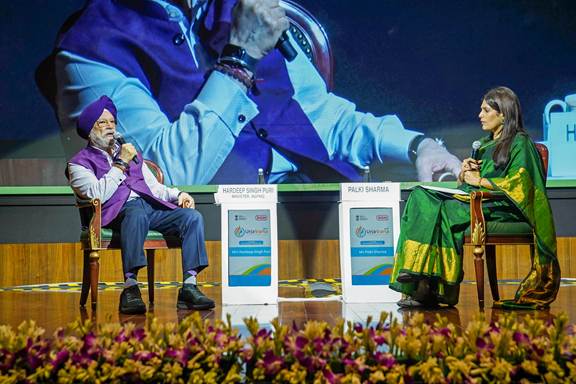At the second edition of Urja Varta 2025, held at Bharat Mandapam in New Delhi, Union Minister of Petroleum and Natural Gas, Hardeep Singh Puri, outlined India’s ambitious strategy to strengthen its upstream exploration and production sector, enhance energy security, and foster international collaboration. Organized by the Directorate General of Hydrocarbons (DGH) under the Ministry of Petroleum and Natural Gas (MoPNG), the conclave, themed “Collaborate, Innovate, Synergize,” brought together over 700 participants, including Union and State Ministers, global industry leaders, experts, and media professionals, to discuss India’s energy roadmap.
In a fireside chat, Minister Puri addressed India’s energy security strategy amid global geopolitical challenges, such as the Russia-Ukraine conflict and Middle East tensions. He highlighted India’s diversification of crude oil imports from 27 to 40 countries to ensure supply stability during turbulent times. On Russian oil imports, Puri noted Russia’s significant role as a top global oil producer, with an output exceeding 9 million barrels per day. He cautioned that removing this supply from the global market of approximately 97 million barrels daily would have driven oil prices to $130–$200 per barrel, causing market chaos. Puri clarified that India has never purchased sanctioned cargo, emphasizing that Russian oil operates under a price cap, not global sanctions, and credited Prime Minister Narendra Modi’s leadership for India’s balanced approach, positioning it as a stabilizing force in global energy markets.
The Minister detailed transformative reforms over the past decade to make India’s upstream sector globally competitive. The restructured Oilfields Regulation and Development Act (ORDA) introduces a co-designed exploration framework, a single lease and approval mechanism, transparent rules, and a “no-sit” clause to eliminate inactive acreage. Integrated with the revised Petroleum and Natural Gas Rules (PNG Rules 2025) and Model Revenue Sharing Contracts (MRSC), these reforms aim to simplify operations and attract private investment. The Hydrocarbon Exploration and Licensing Policy (HELP) and ORDA amendments have unlocked nearly 1 million square kilometers of previously restricted “No-Go” areas, significantly expanding India’s resource potential.
Puri expressed strong optimism about India’s offshore energy prospects, particularly in the Andaman Basin, which he likened to the prolific Guyana basin. “I am positive we will find several fields of the size of Guyana, particularly in the Andaman Sea,” he said, citing enhanced geoscientific data, robust regulations, and incentives to de-risk exploration. India aims to become a leading frontier for deepwater oil and gas exploration by leveraging scale, demand continuity, and global partnerships.
To bolster subsurface intelligence, the government is modernizing its seismic database through extensive surveys, advanced technologies, and the National Data Repository, promoting transparent, data-driven decision-making for investors. Addressing concerns about long-term supply security amid sanctions on Iran and Venezuela, Puri highlighted emerging oil sources from Brazil, Guyana, and Canada, noting the increasing resilience of global oil markets. He reassured stakeholders of India’s readiness to manage potential disruptions.
Domestically, Puri emphasized the critical role of State governments in energy development, urging stronger Centre-State cooperation. “Our states are the core of India’s energy transformation and transition,” he said, calling for states to expedite infrastructure projects as exemplars of good governance.
The conclave featured significant announcements, including the launch of the revised PNG Rules and MRSC to enhance policy clarity and investor confidence. Puri announced Hydrocarbon Resource Assessment Studies using global methodologies to better estimate India’s resource base. Key MoUs were signed, including one between BP and ONGC for stratigraphic well studies and another between DGH and NIC for a cloud-based National Data Repository. The Minister also released the India Hydrocarbon Outlook 2024–25, DGH’s flagship report providing insights for future exploration and production strategies.
Puri visited the Exhibition Gallery and Innovation Center, which showcased over 50 technical posters and 15 innovative solutions from E&P operators, start-ups, and academic institutions, underscoring the role of technology in shaping India’s upstream industry.
An Inter-Ministerial Round Table with representatives from 22 States and Union Territories, held on the sidelines, reflected cooperative federalism. Puri noted that India has invested over ₹4 lakh crore in energy infrastructure over the past decade, with ₹30–35 lakh crore planned for the next decade. He highlighted India’s 16% contribution to global oil demand growth over the past five years and its projected 25% share of incremental global energy demand through 2045. “These investments will require leadership and proactive participation from states,” he said, stressing collective action to address challenges.










